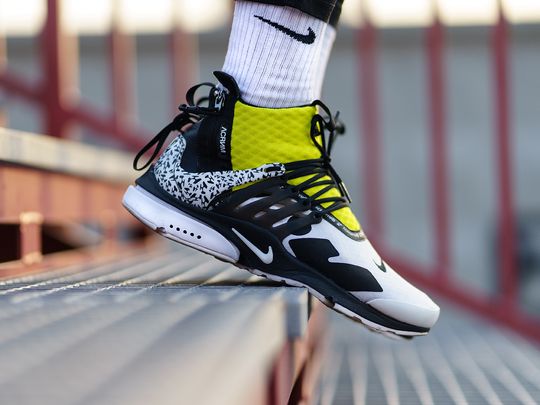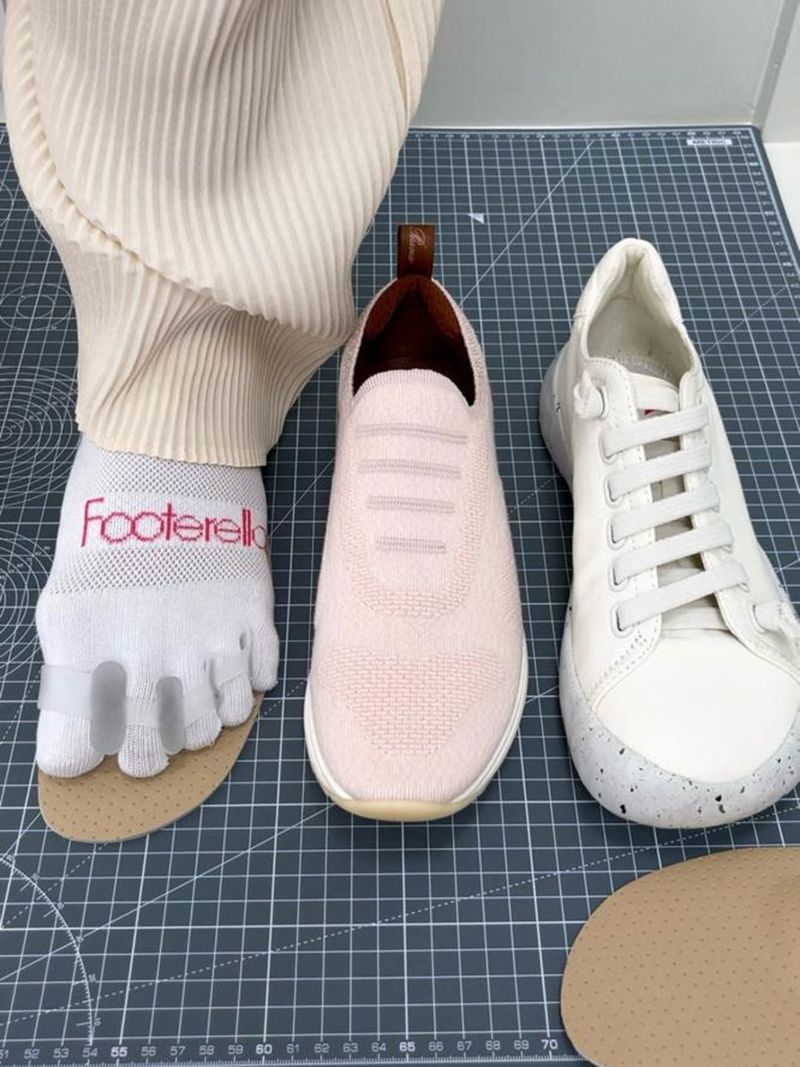
We regularly wear sports shoes that pinch our toes and restrict the natural movement of our soles. Half the pleasure in walking or running is feeling the ground underneath, yet thick soles and fashionably narrow toe boxes rob us of that experience. Not to mention, your feet might be much happier in shoes that are shaped like them.
Barefoot shoes are a type of footwear designed to be as barefoot-feeling and minimal as possible. We spoke with a podiatry expert to help you decide if these deserve a place in your rotation and whether they're actually healthier than regular shoes for sprinting.
Are barefoot shoes better for the feet?
In most cases, ideally, everyone should wear barefoot shoes. Michelle Champlin, chief podiatrist at the Dubai Podiatry Centre, explains: "The main advantages of wearing barefoot shoes are the flexibility of the sole of the shoe, and the width of the toe-box area, allowing the big toe and other toes to function to their maximum capability. Barefoot shoes should allow the foot to be as neutral as possible."
Traditional running shoes usually lift the back of the foot with an added heel height, adds Champlin. In barefoot shoes, your toes and heel enjoy the same level of distance from the ground, just as our natural soles do. Moreover, pinched toes can lead to "ingrown toenails and hard and painful corns on the fifth and fourth toes". Over time, your foot strength can also be affected.
Unless your joints need corrective alignment, barefoot shoes are excellent for the feet. "If there is any bony misalignment, then a shoe with structural support and possibly a corrective alignment orthotic, like toe socks and toe aligners, would be better," said Champlin.
Barefoot shoes are used for rehabilitation purposes, too, as their minimalist sole design strengthens the muscles in the foot. They're your best option when recovering from a sprained ankle.
Can I run in barefoot shoes?

According to our expert, barefoot shoes and running go hand-in-hand. There are some pointers to consider, however, before shopping for a pair. Given that these are zero-drop shoes, the runner has to carefully choose their terrain and style of running.
Naturally, a path strewn with pebbles or laid with stones will not only be uncomfortable for an inexperienced barefoot user, but it also opens up room for injury. A better alternative would be to run on grass or in the sand, says Champlin.
"If the runner is a heel-strike runner, where they put the heel down first, and frequently run on hard surfaces, barefoot shoes may be very uncomfortable. Those wishing to run in barefoot shoes should already be an intermediate-advanced runner that can strike the midfoot to forefoot first," she advised.
Heel-first runners should master the midfoot or forefoot technique in their regular running shoes, before slipping into a barefoot pair. There's little shock absorption in a zero-drop sole, which is why the right foot placement can minimise the shock running from the foot to the knee.
To get the most out of your barefoot shoes, Champlin highly suggests wearing toe socks, which separate each toe. Regular one-piece socks hinder natural toe movement, rendering the wide toe box of your shoe futile.
You can find our podiatrist's recommended barefoot shoes below. Champlin adds that 'barefoot-style' options with a spacious toe box can also be found in accessible brands like Crocs and Birkenstock. Get these from Amazon with a Prime membership to get free, same-day delivery.
1. Best Overall: Vivobarefoot Primus Lite III Women's Low-Top Trainers
Pros
- Great for cross-training and running
- 2mm high-performance sole with protective underfoot
- Hexagonal sole design gives multidirectional flexibility and grip
- Weighs only 182 grams
Cons
- Expensive
Vivobarefoot is a household name you'll come across often in your search for the best barefoot shoes. Champlin recommends its running shoe to "get the full muscle tone from a normal-aligned fit" while sprinting. The Primus Lite trainers are the pair for the job. Its 2mm-high neutral outsole and Ortholite insole are so flexible that you can roll the shoe into a ball. They're made for training naturally, with your feet as close to the ground as possible. There's a 0.8mm layer of protective underfoot that keeps your feet safe from foreign objects and sharp bits. While the shoe is great for advanced barefoot runners or light running for beginners, the Primus Lite III can be worn during weight training, HIIT workouts (high intensity interval training) and CrossFit exercises, too. Reviewers say they get complete contact with the ground while training, making it a wonderful experience. The rubber outsole also has a reliable grip on the road, they add.
Bonus: Buy with 0% instalments and pay Dh61.17 for 12 months with select banks.
2. Best for City Walking: Camper Women's Shoe Sneaker
Pros
- Trendy sneakers for urban walking
- Slip-on shoes
- Sturdy leather upper and rubber outsole
- Traction patterns under the foot
Cons
- Fixed laces
Your stylish holiday sneaker for touring cities, the Camper Peu Cami shoe recreates the feeling of walking barefoot. Our expert recommends these for their sturdy construction, namely the leather upper, which is more suitable for taking on city strolling. Camper uses sustainable leather for the exterior of the shoe and rubber with traction patterns for the outsole. Despite the lace design, the sneakers are slip-on-style and don't need tying. They're comfortable for those with wide feet, as expected. Reviewers do add that the fixed laces can be an issue for bigger feet to squeeze past.
Bonus: Buy with 0% instalments and pay Dh43.75 for 12 months with select banks.
3. Best for Road Running: Xero Men's HFS Running Shoes
Pros
- Breathable upper mesh
- 5.5mm sole with a removable insole
- Tyre tread-inspired traction pattern
- Suitable for off-road running
- 5,000-mile guarantee on the sole
Cons
- The insole can slide around
If you're in the market for barefoot running only, then the Xero HFS will serve you well. These are designed specifically for road running, weighing just 192 grams and constructed with a tyre tread-inspired outsole for off-road sprints, too. While the 5.5mm sole looks thicker than others, the HFS has a 3.5mm removable insole, so you can get a more grounding experience on runs. It still offers a zero-drop heel for proper running posture and a roomy foot-shaped toe box. Each pair is meant to last you 8,046km. Reviewers leave their regular running shoes behind after trying these out, no longer getting a muscle pull or strain. Since they ball up easily, they're also great for squeezing into a duffle bag.
Bonus: Buy with 0% instalments and pay Dh60.40 for 12 months with select banks.
4. Best with Cushioning: Vibram Men's V-Run Running Shoe
Pros
- Separates the toes while running
- Perforated and breathable mesh upper
- Shock absorption in the midsole and insole
- Elastic laces for a snug fit
Cons
- Can take time to get used to
- Not a flattering shoe
Experienced barefoot runners might want to look into Vibram's signature five-toe design. However, getting used to separated toes can make it the most challenging type of barefoot shoe, says Champlin. The V-Run running shoe offers the raw, natural movement of the feet, complete with shock-absorbing EVA cushioning in the midsole and insole. It lets you feel every strike in your run. The stretch mesh in the perforated upper maximises breathability and keeps the feet cool. This pair is excellent for those wanting to switch to a minimalist approach while still keeping sufficient cushioning, say reviews. They note how the shoes activate different muscle groups than in conventional trainers, all the while making your legs feel rested and free of joint aches.
Bonus: Buy with 0% instalments and pay Dh45.76 for 12 months with select banks.
5. Best Sandals: Xero Shoes Z-Trail
Pros
- Great for travelling as they're water-resistant, portable and all-terrain
- Grips floor very well, even if wet
- Adjustable straps with velcro
- Sturdy, lightweight pair
Cons
- Toe area can be slightly narrower than shoes
For more foot freedom on walks, barefoot sandals can you give you the room you need. Xero's Z-Trail shoes have a zero-drop, non-elevated heel and a 10mm sole that's thick enough for hiking, running and even water activities, but thin enough for rolling up and tossing in your pack or pocket. The outsole is covered with a variety of tread patterns for this purpose. They're also up to 76 per cent lighter and thinner than most sport sandals. Your feet are secured by Z-style webbing, with no dividers between toes, and a velcro strap at the heel. Reviewers find them flattering for trips and travel, as they lack the bulbous upper found in barefoot trainers. The straps are easily adjustable and don't slip, either. Users have worn them on hikes, through wet terrain and in swamps, and were able to rinse and dry them just fine.
Our recommendations are independently chosen by Gulf News editors. If you decide to shop through links on our website, we may earn an affiliate commission, as we are part of Amazon Services LLC Associates Program.









